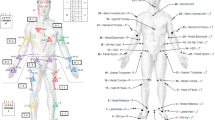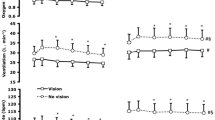Abstract
When stepping down from one level to another, the leading limb has to arrest downward momentum of the body and subsequently receive and safely support bodyweight before level walking can begin. Such step downs are performed over a wide range of heights and predicting when and where contact between the landing limb and the lower level will be made is likely a critical factor. To determine if visual feedback obtained after movement initiation is habitually used in guiding landing behaviour, the present study determined whether pre-landing kinematics and the mechanics of landing would be modulated according to the type of visual feedback available during the stepping down phase. Ten healthy participants (32.3 ± 7.9 years) stepped, from a standing position, down from three different heights onto a forceplatform, either coming immediately to rest or proceeding directly to walking across the laboratory. Repeated trials were undertaken under habitual vision conditions or with vision blurred or occluded 2–3 s prior to movement initiation. Pre-landing kinematics were assessed by determining, for the instant of landing, lead-limb knee and ankle angle, stepping distance, forwards positioning of the body CM within the base of support and the forwards and downwards body CM velocity. Landing mechanics for the initial contact period were characterized using lead limb vertical loading and stiffness, and trail limb un-weighting. When vision was occluded movement time, ankle plantarflexion and knee flexion were significantly increased compared to that determined for habitual vision, whereas forwards body CM positioning and velocity, vertical loading and stiffness, and trail limb un-weighting, were significantly reduced (p < 0.05). Similar adaptations were observed under blurred conditions, although to a lesser extent. Most variables were significantly affected by stepping task and step height. Subjects likely reduced forwards CM position and velocity at instant of landing, in order to keep the CM well away from the anterior border of the base of support, presumably to ensure boundary margins of safety were high should landing occur sooner or later than expected. The accompanying increase in ankle plantarflexion at instant of landing, and increase in single limb support time, suggests that subjects tended to probe for the ground with their lead limb under modified vision conditions. They also had more bodyweight on the trail limb at the end of the initial contact period and as a consequence had a prolonged weight transfer time. These findings indicate that under blurred or occluded vision conditions subjects adopted a cautious strategy where by they ‘sat back’ on their trail limb and used their lead limb to probe for the ground. Hence, they did not fully commit to weight transfer until somatosensory feedback from the lead limb confirmed they had safely made contact. The effect of blurring vision was not identical to occluding vision, and led to several important differences between these conditions consistent with the use of impoverished visual information on depth. These findings indicate that online vision is customarily used to regulate landing behaviour when stepping down.




Similar content being viewed by others
Notes
No alpha level correction was undertaken because to do this one should theoretically count every test performed in developing the model for it to have any real meaning. As this could lead to significant deviations in the alpha levels used for establishing statistical significance between similar looking final models, we did not make such adjustments.
The (light scattering) blur lenses used in the present study reduced contrast sensitivity (CS) to a level similar to that of a relatively dense cataract (Elliott et al. 2000). As it has been shown that reductions in CS (rather than visual acuity) are related to postural instability (Lord et al. 1991a, b; Turano et al. 1994; Lord and Menz 2000) and falls in the elderly (Grisso et al. 1991; Lord et al. 1991a, b; Lord and Menz 2000), the results presented here regarding the effects on landing behaviour of blurring vision, provide some insight into how stepping down might be affected in an elderly person with visual impairment.
References
Buckley JG, Heasley KJ, Twigg P, Elliott DB (2005) The effects of blurred vision on the mechanics of landing during stepping down by the elderly. Gait Posture 21:65–71
Craik RL, Cozzens BA, Freedman W (1982) The role of sensory conflict on stair descent performance in humans. Exp Brain Res 45:399–409
Elliott DB, Patla AE, Furniss M, Adkin A (2000) Improvements in clinical and functional vision and quality of life after second eye cataract surgery. Optom Vis Sci 77:13–24
Everett BS (2003) Generalised linear models for longitudinal data. Modern medical statistics, Chap. 2. A Practical Guide, Arnold
Grisso JA, Kelsey JL, Strom BL, Chiu GY, Maislin G, O’Brien LA, Hoffman S, Kaplan F (1991) Risk factors for falls as a cause of hip fracture in women. The northeast hip fracture study group. N Engl J Med 324:1326–1331
Hof AL, Gazendam MG, Sinke WE (2005) The condition for dynamic stability. J Biomech 38:1–8
Hollands MA, Marple-Horvat DE (1996) Visually guided stepping under conditions of step cycle-related denial of visual information. Exp Brain Res 109:343–356
Hortobagyi T, DeVita P (2000) Muscle pre- and coactivity during downward stepping are associated with leg stiffness in aging. J Electromyogr Kinesiol 10:117–126
Liebermann DG, Goodman D (1991) Effects of visual guidance on the reduction of impacts during landings. Ergonomics 34:1399–1406
Liebermann DG, Hoffman JR (2005) Timing of preparatory landing responses as a function of availability of optic flow information. J Electromyogr Kinesiol 15:120–130
Lord SR, Clark RD, Webster IW (1991a) Postural stability and associated physiological factors in a population of aged persons. J Gerontol 46:M69–M76
Lord SR, Clark RD, Webster IW (1991b) Visual acuity and contrast sensitivity in relation to falls in an elderly population. Age Ageing 20:175–181
Lord SR, Menz HB (2000) Visual contributions to postural stability in older adults. Gerontology 46:306–310
Lyon IN, Day BL (1997) Control of frontal plane body motion in human stepping. Exp Brain Res 115:345–356
Pasternak T, Greenlee MW (2005) Working memory in primate sensory systems. Nat Rev Neurosci 6:97–107
Patla A (1997) Understanding the roles of vision in the control of human locomotion. Gait Posture 5:54–69
Patla AE, Vickers JN (1997) Where and when do we look as we approach and step over an obstacle in the travel path? Neuroreport 8:3661–3665
Patla AE, Rietdyk S, Martin C, Prentice S (1996) Locomotor patterns of the leading and the trailing limbs as solid and fragile obstacles are stepped over: some insights into the role of vision during locomotion. J Mot Behav 28:35–47
Peterka RJ (2002) Sensorimotor integration in human postural control. J Neurophysiol 88:1097–1118
Rietdyk S, Rhea CK (2006) Control of adaptive locomotion: effect of visual obstruction and visual cues in the environment. Exp Brain Res 169:272–278
Santello M (2005) Review of motor control mechanisms underlying impact absorption from falls. Gait Posture 21:85–94
Santello M, McDonagh MJ (1998) The control of timing and amplitude of EMG activity in landing movements in humans. Exp Physiol 83:857–874
Santello M, McDonagh MJ, Challis JH (2001) Visual and non-visual control of landing movements in humans. J Physiol 537:313–327
Turano K, Rubin GS, Herdman SJ, Chee E, Fried LP (1994) Visual stabilization of posture in the elderly: fallers vs. nonfallers. Optom Vis Sci 71:761–769
Acknowledgments
John Buckley was supported by a NAHP Research Training fellowship from The Health Foundation, UK (ref: 3991/3322). The authors thank Lee Street for conducting the focimetry assessment to determine subjects’ spectacle prescription, and for her help determining subjects’ vision measurements, and thank Brendan Barrett and Dave Elliott for critical feedback on an initial draft of the manuscript.
Author information
Authors and Affiliations
Corresponding author
Rights and permissions
About this article
Cite this article
Buckley, J.G., MacLellan, M.J., Tucker, M.W. et al. Visual guidance of landing behaviour when stepping down to a new level. Exp Brain Res 184, 223–232 (2008). https://doi.org/10.1007/s00221-007-1096-8
Received:
Accepted:
Published:
Issue Date:
DOI: https://doi.org/10.1007/s00221-007-1096-8




